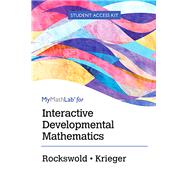For courses in developmental mathematics.
Giving Meaning to the Numbers
Gary Rockswold and Terry Krieger give meaning to the numbers that students encounter by developing concepts in context through the use of applications, multiple representations, and visualization. By seeing the concept in context before being given the mathematical abstraction, students make math part of their own experiences instead of just memorizing techniques. Research is showing that this method is essential to empowering students. Seamlessly integrated real-life connections, graphs, tables, charts, and meaningful data help students deepen understanding and prepare for future math courses—and life—by teaching them critical thinking and problem-solving skills.
Built in MyMathLab
Interactive Developmental Mathematics offers a completely digital experience, built by Gary Rockswold and Terry Krieger from the ground up in MyMathLab to model the way today’s students learn and interact online. MyMathLab is an online homework, tutorial, and assessment program designed to engage students and lead them to master the concepts and skills they need to succeed in math. Within its guided learning environment, students practice what they learn, test their understanding, and pursue a personalized study plan that helps them master course material and understand difficult concepts.











